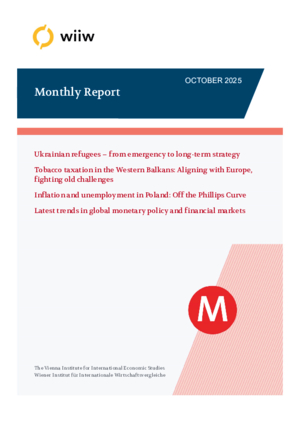Monthly Report No. 10/2025
Kristijan Fidanovski, Biljana Jovanovikj, Nóra Kungl, Leon Podkaminer and Maryna Tverdostup
wiiw Monthly Report No. 10, October 2025
42 pages including 10 Tables, 39 Figures
Current issues accessible exclusively for Members. Free access after an embargo period of six months.
- Ukrainian refugees – from emergency to long-term strategy
by Maryna Tverdostup
Three and a half years after the start of Russia’s full-scale invasion of Ukraine, Europe is still living with the largest refugee movement since the Second World War. The first phase of the crisis was all about speed and compassion, with borders opened, communities mobilised and protection offered on an unprecedented scale. But that urgency is now behind us. What lies ahead is less visible but equally demanding: namely how to turn temporary arrangements into long-term strategies that work both for refugees and for the countries that host them.
- Tobacco taxation in the Western Balkans: Aligning with Europe, fighting old challenges
by Kristijan Fidanovski, Biljana Jovanovikj, Nora Kungl
Tobacco use remains a major public health issue in the Western Balkans, where smoking prevalence is among the highest in Europe. This article reviews recent trends in tobacco taxation, cigarette affordability, illicit trade and the growth of heated tobacco products (HTPs) across the six Western Balkan countries (WB6). While progress has been made in aligning excise structures with EU regulation, tax levels in several countries remain below the current EU minimum and well short of the newly proposed threshold. At the same time, illicit trade in manufactured cigarettes has declined, creating scope for tougher fiscal measures. More ambitious taxation and regulation, particularly of HTPs, could advance public health while supporting the strained public finances of the Western Balkan countries.
- Inflation and unemployment in Poland: Off the Phillips Curve
by Leon Podkaminer
Phillips Curves, which show the correlation between the rate of inflation and the rate of unemployment on a scatter plot, often suggest a trade-off between the two. Data for Poland that run from Q1 2001 through Q4 2024 may also suggest the existence of a downward-sloping Phillips Curve. But a closer look at the data indicates the absence of any such trade-off. Instead, one detects asymmetry of causation. While changing inflation rates do indeed affect unemployment, the opposite is not the case: changing unemployment rates do not affect inflation. Moreover, the relationship between inflation and unemployment is found to be positive, unlike in the usual interpretations of Phillips Curves.
- Latest trends in global monetary policy and financial markets
by Biljana Jovanovikj
Global monetary policy has entered a cautious easing phase as uncertainty increased significantly amid trade tensions, supply-chain risks and softer global demand. In recent months, major central banks have diverged in their responses: the US Fed and the Bank of Canada have cut policy rates, while others have paused, reflecting country-specific inflation risks and external vulnerabilities. Markets now expect a slower pace of easing, with additional cuts pushed into late 2025 and 2026 – except in Japan, where policy normalisation is expected to advance gradually.
Reference to wiiw databases: wiiw Monthly Database, wiiw FDI Database
Keywords: refugees, temporary protection, labour market integration, tobacco-use prevalence, tobacco taxation, illicit trade in tobacco, cigarette affordability, heated tobacco products, inflation, unemployment, Phillips Curve, Granger causality, impulse response function, policy rates, inflation, yield curves
Countries covered: Canada, EU, Euro Area, Japan, Poland, Switzerland, Ukraine, United Kingdom, US, Western Balkans
Research Areas: Macroeconomic Analysis and Policy, Labour, Migration and Income Distribution, Sectoral studies
